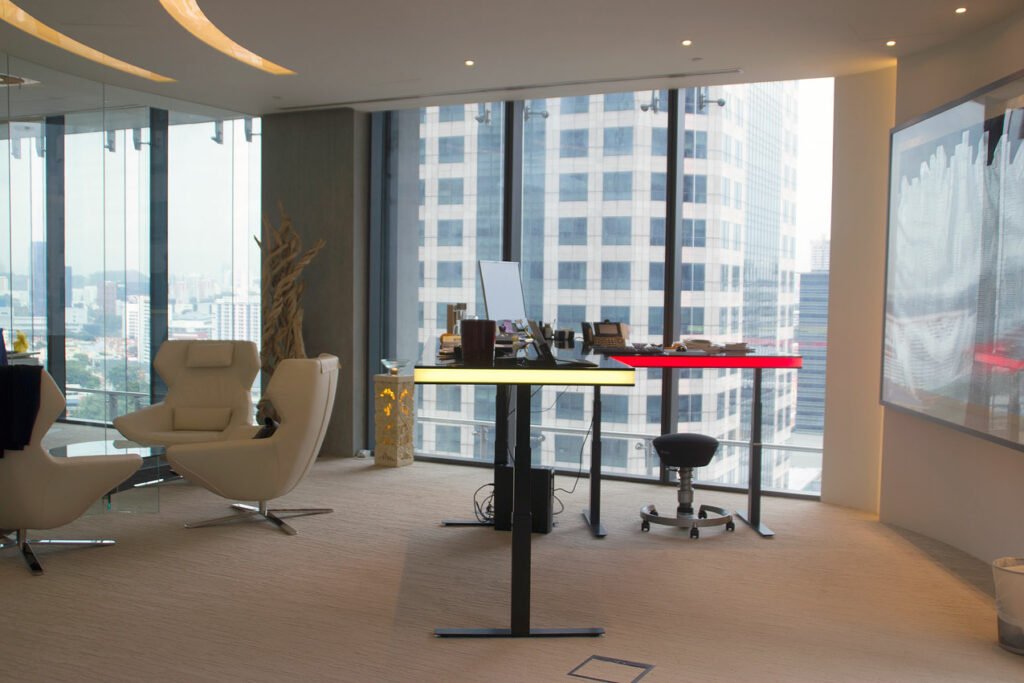
Diverse Workspaces: These type of work environments feature a range of workspaces, including quiet zones for concentrated tasks, collaborative areas for team projects, meeting rooms, and informal spaces for socialising or brainstorming.
Flexible Furniture: Furniture in ABW settings is adaptable and movable to accommodate different work styles and preferences. This includes adjustable desks, ergonomic chairs, and modular seating arrangements.
Technology Integration: Robust IT infrastructure supports seamless connectivity across various workspaces. Employees can access necessary tools and resources from any location within the office.
Storage Solutions: Given that employees do not have permanent desks, personal lockers and secure storage options are provided to store belongings.
Clear Policies and Guidelines: Effective activity-based working implementation requires clear policies on how spaces should be used, including meeting room booking systems and guidelines for maintaining a respectful and productive environment.
Implementing ABW isn’t just about design; it’s about data. Workplace analytics tools can offer real-time insights into space utilisation. This data helps businesses identify which areas are most popular or underused, allowing them to refine the office layout continuously. For example, if certain collaborative spaces are frequently used while others remain empty, adjustments can be made to accommodate employee behaviour and preferences better.
If you’re faced with the challenge of appealing to many different employee needs, ABW could solve many of the issues you face daily. By having a variety of work settings, such as hot desks with desk booking system, informal booths, and standing desks, you’ll encourage employees to come together as a team and collaborate.
The right mixture of private and open spaces will free up staff to use their work in the way that suits them best.
When employees become unshackled from the constraints of a traditional desk, they’ll find the most productive way to work based on their own needs.
Transitioning to an activity-based working model requires careful change management to ensure a smooth process. Businesses should consider phased rollouts, starting with a small pilot area to gather initial feedback and adjust accordingly.
Staff training sessions on how to effectively use different zones and technology, along with regular communication about the benefits of ABW, can significantly reduce resistance. Leadership buy-in and clear, ongoing dialogue are key to successfully adopting this flexible working model.
There’s a tendency to think that ABW should focus more on collaborative spaces and open areas. However, diverse teams must be flexible enough to adapt their allocated home zones to suit their needs. In a research piece by global office furniture manufacturer Steelcase, researchers found that the harder people work collaboratively, the more important it was for them also to have some time alone.
It’s important to offer a selection of creative, collaborative work settings, from formal hot desking environment to more relaxed soft seating and maybe even a ball pit! But zones should also offer more enclosed, private spaces.
In open-plan offices where this becomes difficult, enclosed pods or areas with acoustic, noise-reducing panels can give staff some much-needed privacy. A healthy mixture of collaborative and private spaces will allow people to organise their workflow in a more productive way, avoiding interruptions and removing stress.
ABW models can enhance employee experience (EX) by promoting personalization and flexibility. Employees appreciate the autonomy to choose their workspace based on their mood or task, directly contributing to improved well-being. Wellness features such as relaxation zones, biophilic design elements, and access to outdoor spaces can further boost morale. Additionally, integrating activity-based working with hybrid work policies can ensure that employees feel supported in the office or remotely.
Embracing ABW can sometimes be a hard sell.
Management must come to terms with freeing up their staff to choose their own space. More structured businesses might take a while to accept this looser, some would say chaotic working style.
There’s also a chance that staff won’t like the idea of giving up their own desk since we have a habit of nesting! Something that can help to overcome this is the use of improved office furniture.
Hot desks don’t seem quite daunting when the task chairs are much more ergonomically designed. And it’s surprising how many more meetings will take place when there’s a bright, spacious break-out area with sofas and armchairs to have it in.
Once ABW is implemented, gathering ongoing employee feedback is essential to ensure its effectiveness. Surveys and focus groups can help measure satisfaction with the new layout and identify areas for improvement. By continuously adapting the office design based on user feedback, businesses ensure that their workplace evolves with employee needs, making it a dynamic and responsive environment.
The benefits far outweigh any challenges that arise. In fact, many businesses that opt for activity-based working notice:
With the added option of adjustable standing desks, employees can stretch their legs while they work. Some organisations have even experimented with treadmill desks!
Integrating cutting-edge technologies will become essential as businesses evolve toward more flexible office models. Innovations like IoT sensors can track occupancy and environmental conditions in real-time, while AI-powered workplace management systems can help optimise employees’ flow through various spaces. Smart office technologies improve efficiency and offer valuable insights into how people use different spaces, supporting more effective ABW designs.
Working with the right office design specialists, businesses can not only improve their workplace’s aesthetics but also positively impact productivity and efficiency. By highlighting employees’ different behaviour in the workplace, you can create an environment that provides them with the spaces they need to do their jobs effectively. It’s a win-win situation.
This is a guest post by Paramount Interiors. Paramount Interiors is one of the UK’s leading office design and fit-out companies, specialising in creating workplaces that improve productivity and encourage collaboration. We asked them to take a look at how activity-based working can be reflected in the design of a workplace.
Subscribe to the monthly newsletter!
By clicking the “Subscribe” button above, you agree to the Terms & Conditions and Privacy Policy
2014 – 2025 Proudly designed and made in Lithuania